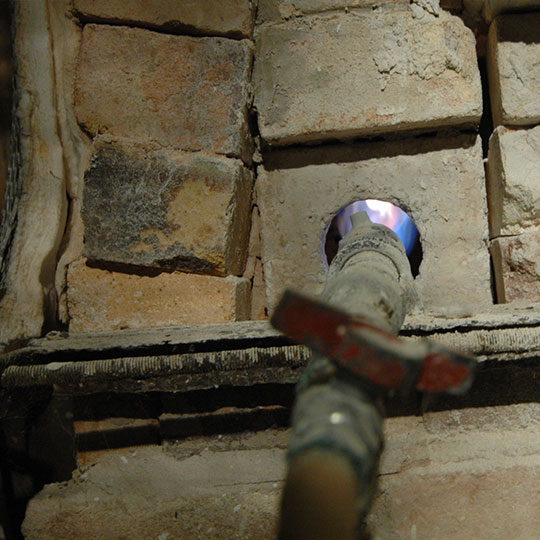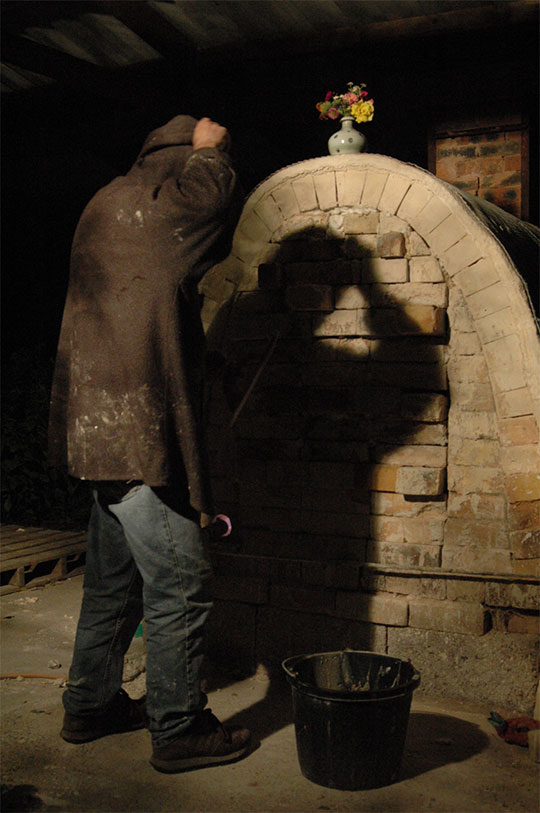Troubled Light
The Irish potter Jack Doherty was creative director and lead potter at the Leach Pottery, St Ives, from 2008 to 2013. This is the story of one of his final firings in St Ives.
‘As I contemplate the blue of the sky … I do not possess it in thought, or spread out towards it some idea of blue as might reveal the secret of it, I abandon myself to it and plunge into this mystery, it ‘thinks itself within me’, I am the sky itself as it is drawn together and unified, and as it begins to exist for itself; my consciousness is saturated with this limitless blue.’
(Merleau-Ponty, 1945: 249)
He drives across the moor, jumpy on the brakes, the bracken flashing russet in the headlamps like pots where the slip has been sprayed thin. Then down to the coast and home, which brings only a measure of comfort. He has left the kiln behind him, still warm to the touch, its stacks of cooling pots like prisoners in battleship grey. It has been a disastrous firing. And it seems, in some way that he cannot quite grasp, that the darkness in his life has manifested physically within the kiln. Malevolent forces have drained the spirit from his pots, leaving their colourless husks behind. But colour itself, Goethe writes, is a degree of darkness. Colour is troubled light (Goethe, 1810: 69).
He asks himself what went wrong. The procedure is simple – no stain, no glaze – just copper slip sprayed onto dry pots. And this was a new batch of slip, carefully measured. Was it too thickly sprayed? This seems likely. It was a dreadful day, the pottery seething with angry ghosts and the sort of contemporary conflicts from which he is inclined to hide. Distracted and beleaguered, he sprayed quickly, wanting to get the job done. But the spraying of slip on pots is not a random act, although he sometimes thinks it is. The knowledge of it belongs to a part of his mind that does not connect to conscious thought.

This firing was no different from others. It was December, the darkness broken by the lights of passing cars and the kiln’s crucible glow, the hiss of gas, the smell of his own anxious sweat, and the arc of bricks, slack with age and tightening in the heat. Alarming cracks come from within, but these do not worry him. He knows his kiln; they have been together for a long time. He plays the kiln for hours, stifling it until the flame darkens, then flooding it with air, and all the time he is teasing the copper from the pots. She is his element, the source of colour in his work, but flirty and volatile, never settling, always wanting something else. Copper needs a good seeing to and he is very skilled, it is all about timing. He can get her to release, sometimes, into blue-green and smoky grey, lemon and sienna. Yellow is a light which has been dampened by darkness; blue is a darkness weakened by light (Goethe, 1810: 502). And blue, his brightest blue, happens where copper and sodium meet.
He does not always fire the kiln alone, but that day there is no-one to share the mundane and romantic ritual. His solitary footsteps traverse the car park between pottery and kiln; boiling kettles, dissolving bicarbonate of soda, spraying the solution into the kiln (he is a world expert, he says, in the mechanics of a garden sprayer). The soda spray rises on currents of flame, brushing the surfaces of the pots inside. In this too he surrenders to chance far less than he imagines, it is just that his knowledge is lodged somewhere that language cannot reach. But this time the chemistry does not work. Whether the slip was sprayed too thickly, the temperature too low, or whether the pots have been mysteriously infected by the bleakness of his mood, they emerge in dull and uniform grey, each and every one. Their forms are strong, but without colour they have no voice and he needs them to sing for him in urgent and specific ways. The boxes are ready to send them abroad, the exhibition waiting, and there is no back-up plan.

His process – that last bastion of skill – has betrayed him when he needed it most. There are many kinds of treachery, he knows that, but betrayal is betrayal wherever you find it (Winterson, 1985: 110). He is physically and emotionally exhausted. There is nothing left. And then he thinks: ‘You’re going to have to do something.’ If the firing has become a microcosm of his life he cannot walk away from it empty-handed, he is grappling with something bigger than a kiln. So he bricks it up to fire it again in the morning. The same kiln, the same pots. He knows that he will not sleep. To fire a second time is to risk losing everything but, in another way, there is nothing to lose. The battle is stripped down to the simple level of loss and gain. ‘I would do all this,’ he says, ‘for one good pot.’
The morning is grey and dark, and he has very little hope. But he lights the burners, plays the familiar waiting game. All his firings are fuelled by anxiety, but this one is also driven by cussedness and courage, the refusal to admit defeat. He is drawing on the knowledge lodged in raw nerves and tired muscle; there is neither precedent nor plan. But there are choices: To fire in the same way? To fire without the soda? What would happen? In the end, he follows the same pattern, the one that didn’t work before, layering one firing over another – the same amount of soda, the same reduction sequence, possibly a few degrees higher. And he is more direct with the soda, blasting the surface of the pots, willing something to happen.
And it does.
He opens the kiln and is engulfed in colour, the blue of sea and sky, the broken texture of water in wind and sunlight with deeper blue, inky and strong, breaking through the grey. All the pots are good, not a dullard amongst them. He knows, in this moment, that change is on its way. And desire, the restless longing that drives him, returns magnified and full of possibility. There are colours here that he has not seen before – flickers of orange and pink, flashes of bronze and fearless blue.
I write with a pot on the desk, one of the twice-fired. Round, not large, it makes sense within cupped hands, its surface textured like lichen-covered rock. It carries emotion in its form, but its voice is in colour; the metallic clouds that move across its surface and the strong pure blue beneath them. There is deeper blue along the rim, drifts of dawn pink and primrose-pale yellow, and gold spreading from the base in a flush of prophesy and hope. And it has meaning beyond itself because it comes from a place where endings make way for beginnings, and darkest-hour pots emerge in daybreak colours.
This article was first published in Ceramic Review, Issue 261
Images © Ellen Doherty
Notes
Merleau-Ponty, Maurice, The Phenomenology of Perception (1945)
Goethe, Johann, Theory of Colours (1810),
Winterson, Jeanette, Oranges Are Not the Only Fruit (1985)
Goethe, Johann, Theory of Colours (1810),
Winterson, Jeanette, Oranges Are Not the Only Fruit (1985)
